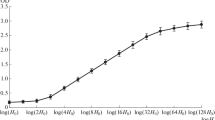Summary
Ultracentrifugation of living cells from the liver of the mouse, rat, dog, frog, Necturus, follicle cells, of grasshopper testis, and meristem of the onion root tip shows evidence that the interphase chromatin is attached to the nuclear envelope. Because of its relatively high density, the bulk of the interphase chromatin, and often the nucleoli, are displaced to the centrifugal side of the nucleus and, when this occurs, the chromatin bodies attached to the centripetal side of the nucleus are drawn out into long filaments which extend across the nucleus centrifugally. They generally break before becoming detached from the envelope. Onion root tip chromosomes in early prophase also appear to be attached to the nuclear envelope. The Barr body strongly adheres to the nuclear envelope as evidenced by the high centrifugal force necessary to displace it. Nucleoli of ultracentrifuged meristematic cells of the onion root show evidence of a stratification of materials within them.
Similar content being viewed by others
References
Barr, M. L.: The significance of the sex chromatin. Int. Rev. Cytol. 19, 35–95 (1966).
Beams, H. W.: The effects of ultracentrifuging upon the meiotic chromosomes of the male grasshopper, Melanoplus differentialis. J. Morph. 83, 87–103 (1948).
—, Kessel, R. G.: Properties of the Ehrlich ascites tumor cell as determined by electron microscopy, ultracentrifugation, and hydrostatic pressure. Cancer Res. 28, 1944–1951 (1968).
—, King, R. L.: The effect of ultracentrifuging upon chick embryonic cells, with special reference to the “resting” nucleus and the mitotic spindle. Biol. Bull. 71, 188–198 (1936).
—, Tahmisian, T. N., Devine, R. L., Anderson, E.: Ultrastructure of the nuclear membrane of a gregarine parasitic in grasshoppers. Exp. Cell Res. 13, 200–204 (1957).
Beams, J. W., Weed, A. J., Pickels, E. G.: The ultracentrifuge. Science 78, 338–340 (1933).
Brenner, S.: The chromatic nuclear membrane. Exp. Cell Res. 5, 257–260 (1953).
Comings, D. E.: The rationale for an ordered arrangement of chromatin in the interphase nucleus. Amer. J. hum. Genet. 20, 440–460 (1968).
—, Kakefuda, T.: Initiation of DNA replication at the nuclear membrane in human cells. J. molec. Biol. 33, 225–229 (1968).
DuPraw, E. J.: Macromolecular organization of nuclei and chromosomes: a folded fibre model based on whole-mount electron microscopy. Nature (Lond.) 206, 338–343 (1965).
—: Cell and molecular biology. New York: Academic Press 1968.
Fawcett, D. W.: On the occurrence of a fibrous lamina on the inner aspect of the nuclear envelope in certain cells of vertebrates. Amer. J. Anat. 119, 129–146 (1966).
Gall, G. A.: Chromosome fibers from an interphase nucleus. Science 139, 120–121 (1963).
Gatenby, J. B., Beams, H. W.: The microtomist's vade-mecum, 11th ed. London: J. A. Churchill 1950.
Grumbach, M. M., Morishima, A., Taylor, J. H.: Human sex chromosome abnormalities in relation to DNA replication and heterochromatinization. Proc. nat. acad. Sci. (Wash.) 49, 581–589 (1963).
Jackson, V., Earnhard, J., Chalkley, R.: A DNA-lipid protein containing material isolated from calf thymus nuclear chromatin. Biochem. biophys. Res. Commun. 33, 253–259 (1968).
Jacob, F., Ryter, A., Cuzin, F.: On the association between DNA and membrane in bacteria. Proc. roy. Soc. B 164, 267–278 (1966).
Korson, R.: A differential stain for nucleic acids. Stain Technol. 26, 265–270 (1951).
Lafontaine, J. G.: Structural components of the nucleus in mitotic plant cells. In: The nucleus, edit, by A. J. Dalton and F. Maguenau, p. 151–196. New York: Academic Press 1968.
Luft, J. H.: Improvements in epoxy resin embedding methods. J. biophys. biochem. Cytol. 9, 409–415 (1961).
Monneron, A., Bernhard, W.: Fine structural organization of the interphase nucleus in some mammalian cells. J. Ultrastruct. Res. 27, 266–288 (1969).
Moses, M. J.: The nucleus and chromosomes: a cytological perspective. In: Cytology and cell physiology, edit. by G. Bourne, 3rd ed., p. 423–558. New York: Academic Press 1964.
—, Coleman, J. R.: Structural patterns and the functional organization of chromosomes. In: The role of chromosomes in development. 23 Symp. Soc. Dev. and Growth, edit. by M. Locke, p. 11–49. New York: Academic Press 1964.
Pappas, G. D.: The fine structure of the nuclear envelope of Amoeba proteus. J. biophys. biochem. Cytol. 2 (Suppl.), 431–434 (1956).
Pawlowski, P. J., and Berlowitz, L.: Non-replicating chromatin: Its attachment to the nuclear membrane in mealy bugs. Exp. Cell Res. 56, 154–156 (1969).
Pusa, K.: Some new principles governing chromosome pairing—the spatial relations of chromosomes and nuclear membrane. Proc. XI Int. Congr. Genet. Genetics Today (Abstr.) 1, 110 (1963).
Reynolds, E. S.: The use of lead citrate at high pH as an electronopaque stain in electron microscopy. J. Cell Biol. 17, 208–212 (1963).
Richardson, K. C., Jarrett, L., Finke, E. H.: Embedding in epoxy resins for ultrathin sectioning in electron microscopy. Stain Technol. 35, 313–323 (1960).
Ris, H.: Ultrastructure and molecular organization of genetic systems. Canad. J. Genet. Cytol. 3, 95–120 (1961).
—: Fine structure of chromosomes. Proc. roy. Soc. B 164, 246–266 (1966).
Sabatini, D. D., Bensch, K., Barrnett, R. J.: Cytochemistry and electron microscopy. The preservation of cellular ultrastructure and enzymatic activity by aldehyde fixation. J. Cell Biol. 17, 19–58 (1963).
Watson, M. L.: Staining of tissue sections for electron microscopy by heavy metals. J. Biophys. Biochem. Cytol. 4, 475–479 (1958).
Author information
Authors and Affiliations
Additional information
Supported by Grant GM 04706 from the U.S.P.H.S.
Rights and permissions
About this article
Cite this article
Beams, H.W., Mueller, S. Effects of ultracentrifugation on the interphase nucleus of somatic cells with special reference to the nuclear envelope-chromatin relationship. Z. Zellforsch. 108, 297–308 (1970). https://doi.org/10.1007/BF00336521
Received:
Issue Date:
DOI: https://doi.org/10.1007/BF00336521




